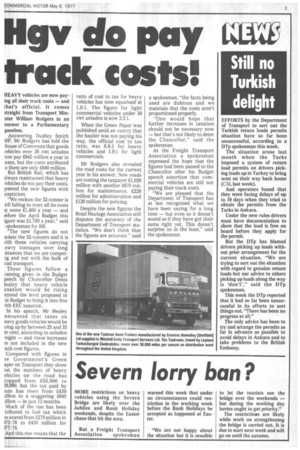Hgv do pay LaW
Page 5

If you've noticed an error in this article please click here to report it so we can fix it.
track costs!
HEAVY vehicles are now paying all their track costs — and that's official. It comes Araight from Transport Minister William Rodgers in an Inswer to a Parliamentary itiestion.
Answering Dudley Smith VIP, Mr Rodgers has told the Rouse of Commons that goods fehicles over 30 cwt unladen low pay £645 million a year in ,axes, but the costs attributed o them are only £640 million.
But British Rail, which has ilways maintained that heavy rehicles do not pay their costs, ;reeted the new figures with ;cepticism.
"We reckon the 32-tonner is till failing to meet all its costs )y some £1,400 a year — and iefore the April Budget this igure was £1,700 a year," said spokesman for BR.
"The new figures do not solate the 32-tonners and it is vith these vehicles carrying Leavy tonnages over long .istances that we are competlg and not with the bulk of oad transport.
These figures follow a yarning given in the Budget peech by Chancellor Denis iealey that heavy vehicle axation would be rising eyond the level proposed in ae Budget to bring it into line rith EEC taxation.
In his speech, Mr Healey nnounced that taxes on eavy goods vehicles would be oing up by between 25 and 35 er cent, according to unladen Tight — and these increases re not included in the new .ack cost figures.
Compared with figures in le Government's Green aper on Transport they show lat the numbers of heavy ehicles on the road has ropped from 635,000 to t9,000, but the tax paid by iem has risen from £430 iillion to a staggering £645 Anon — in just 12 months.
Much of the rise has been :tributed to fuel tax which as soared from £270 million in )75/76 to £430 million for )77/78.
And this rise means that the ratio of cost to tax for heavy vehicles has now equalised' at 1.0:1. The figure for light commercial vehicles under 30 cwt unladen is now 2.5:1.
When the Green Paper was published amid an outcry that the haulier was not paying his way, the official cost to tax ratio, was 0.8:1 for heavy vehicles and 1.9:1 for light commercials.
Mr Rodgers also revealed the road costs for the current year in his answer. New roads are costing the taxpayer £1,020 million with another £670 million for maintenance, £220 million for administration and £120 million for policing.
Despite the new figures the Road Haulage Association still disputes the accuracy of the Department of Transport statistics. "We don't think that the figures are accurate," said a spokesman, "the facts being used are dubious and we maintain that the costs aren't proportioned properly.
"One would hope that further increases in taxation should not be necessary now — but that's not likely to deter the Chancellor," said the spokesman.
At the Freight Transport Association a spokesman expressed the hope that the figures had been passed to the Chancellor after his Budget speech assertion that commercial vehicles are still not paying their track costs.
"We are pleased that the Department of Transport has at last recognised what we have been saying for a long time — but even so it doesn't sound as if they have got their sums right yet. This doesn't surprise us in the least," said the spokesman.
























































































































